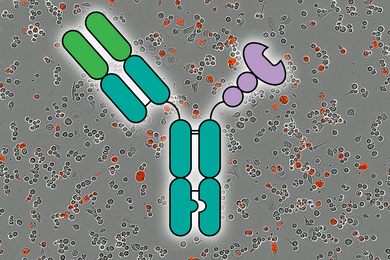CAMBRIDGE, Mass.--A short form of RNA designed by MIT researchers can turn off a targeted gene much the way naturally occurring microRNAs do, MIT researchers report in the Feb. 15 issue of Genes & Development.
RNA--ribonucleic acid--was long thought to be only DNA's messenger, an intermediary that delivered the blueprint for constructing proteins. Researchers have now found that tiny segments of double-stranded RNA, dubbed short interfering RNAs (siRNAs), can be designed to shut down any given gene.
RNA medicines could be developed to treat a host of disorders from high cholesterol to cancer, as well as viral diseases such as AIDS.
MicroRNAs are small, naturally occurring RNA molecules that are similar to siRNAs but that function differently to silence genes. Researchers have identified hundreds of genes that code for them in a wide range of organisms, but no one is sure why they exist.
Small RNAs, 21-25 nucleotides long, work in animals in at least two distinct ways: siRNA pair exactly to mRNA and destroy it, while microRNAs partially pair with mRNAs and repress their translation without destroying the mRNA.
Biology graduate students John G. Doench and Christian P. Petersen and Phillip A. Sharp, Institute Professor and director of the McGovern Institute at MIT, hope to use their newfound information about siRNAs to understand how naturally occurring microRNAs work to stop the translation of certain genes in mammals.
"This study shows that the two silencing pathways are connected," Petersen said. "Researchers have always assumed that siRNAs only act on messenger RNAs to degrade them by RNA interference, but they can also turn off gene expression by halting translation."
"This insight is potentially important for practical reasons as it might indicate that gene silencing with siRNAs could inhibit the expression of genes other than the specific target gene," Doench said. However, the rules controlling repression by microRNAs have not been studied in human cells, and it may be possible to use the system developed by Sharp and colleagues to design siRNAs that are totally gene-specific.
Last June, Sharp and colleagues showed that siRNAs could stop HIV infection in cells grown in the lab. The researchers created siRNAs that inhibited the growth of HIV through gene silencing.
"A lot of really big questions surround the biology of these RNAs, and we think we'll be able to study many of them with this system," Petersen said. "The use of siRNAs to study translational repression holds promise for dissecting the sequence and structural determinants and general mechanism of gene expression by microRNAs," the authors wrote.
This work was supported by the United States Public Health Service MERIT Award from the National Institutes of Health and a program project grant from the National Cancer Institute.





